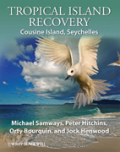
Tropical Island Restoration The Remarkable Story of Cousine Island, Seychelles By Michael J Samways, Peter Hitchins, Orty Bourquin and Jock Henwood, University of Stellenbosch, South Africa Scientific rationale Tropical island species and ecosystems are threatened worldwide as a result of increasing human pressure. Yet some of these islands also lend themselves to restoration, as they are physically defined units that can be given focused attention, as long as resources are available and clear conservation targets are set. Cousine Island, Seychelles, is a tropical island that has received such intensive restoration.From a highly degraded island in the 1960s, the island has now been restored to what is believed to be a semblance of the natural state. All alien vertebrates have been eradicated, as have 25 invasive alien plants. Cultivated plants are now confined to one small section of the island. Poaching of nesting marine turtles has been stopped, leading to an increase in turtle breeding numbers.The shearwater population has increased in size with poaching activities under control. The Sooty tern has also returned to the island to breed. The coastal plateau has been restored with over 2500 indigenous shrubs and trees, which have now grown into a forest carpet. There are strict quarantine procedures onthe island, keeping it free of rats, mice, various alien invertebrates and potentially invasive alien plants. Three threatened Seychelles endemic land birds (Seychelles warbler, Seychelles magpie robin and Seychelles white-eye) have been introduced and are thriving, with these introductions contributing to both the magpie robin and the white-eye being downgraded from CR to EN (the warbler remains at VU). Ecotourism, and nature conservation for the local inhabitants, have been introduced in a way that does not reduce the improved compositional, structural and functional biodiversity of the island. The result of the restoration effort appears to be sustainable in the long term, although challenges still remain, especially with regards to adequate clean water and a non-polluting power supply on the island. Cousine is thus paving the way in the art and science of tropical island restoration as a legacy for future generations.Need for the book There is no other book on this case study. The need for thebook arises from the fact that here is a positive note for conservation in these times of so much negative news on the state of our environment. More importantly, the book shows how such restoration should be done, and is therefore amodel for many other islands around the world. The book has many illustrations so as to give the book wide appeal and literally to show what can done in terms of restoration. All this is based on much scientific detail, including many new data. The aim is, by way of example, to demonstrate how practical restoration, based on sound scientific research, can be carried out for the betterment of ecological integrity and ecosystem health.Michael Samways, Peter Hitchins, Orty Bourquin, and Jock Henwood Departments of Entomology and Conservation Ecology, University of Stellenbosch, South Africa
- ISBN: 978-1-4443-3309-1
- Editorial: Wiley-Blackwell
- Encuadernacion: Cartoné
- Páginas: 260
- Fecha Publicación: 16/04/2010
- Nº Volúmenes: 1
- Idioma: Inglés
